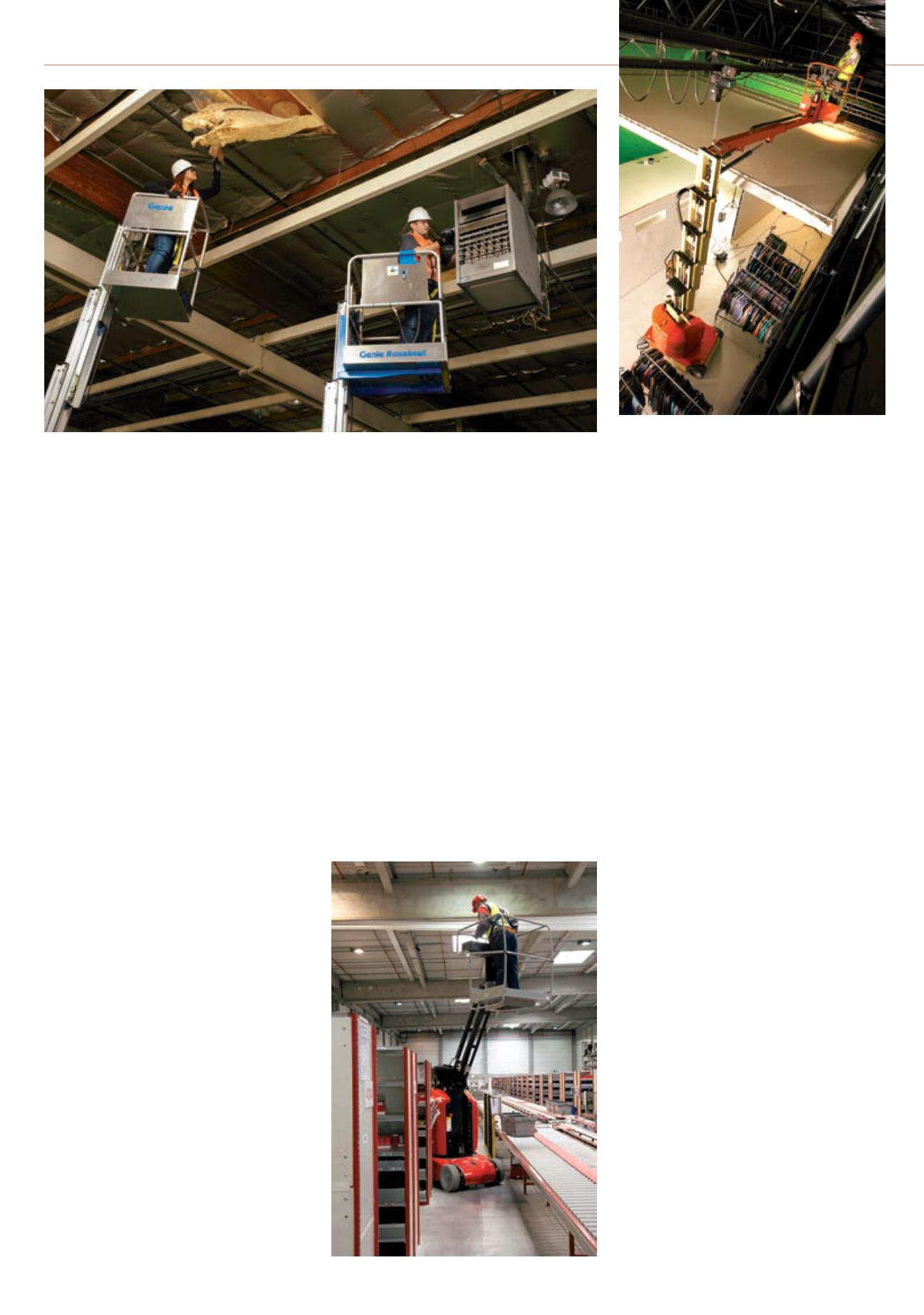
VERTICAL MASTS
16
access
INTERNATIONAL
JANUARY-FEBRUARY 2014
Terex AWP has also been busy. It recently
launched the Genie GR-26J in North America,
which had previously been released in the CE
market.The narrow chassis and jib allow the
machine to be positioned down tight aisle
ways and while accessing up and over shelving
and equipment. Marie Engstrom, associate
product manager at Terex AWP, explains.
“Having a compact base is key for vertical mast
products which are frequently used indoors
and in finished spaces. The comparatively low
machine weight is important when using the
GR-J products in areas that have floor loading
limitations.”
She added there is no immediate news of
new products, but, “We are currently working
on exciting vertical mast innovations that will
increase the productivity for users and provide
exceptional value.”
Compact reach
Compactness and reach was also on the
Snorkel’s mind when it enhanced its M1230E
mast with a 500 mm roll-out deck extension.
This optional extra extends the platform size to
1.46 m, providing additional reach without the
need to move the machine.
Enrique Garcia Delgado, regional sales
manager for Europe, says, “An all-steel chassis,
coupled with the ability to work outdoors on
the slab means it delivers an excellent rental
return on investment.”
The M1230E remains one of Snorkel’s
most popular products, says the company.The
robust reverse concentric mast design gives the
M1230E its lift capacity of 227kg.
As Mr Delgado adds, “It is important to
build machines for the right applications.
So, for example, the M1230E has an all-
steel chassis and mast because it is designed
for construction applications, so it has to be
robust.”
On the other hand, the 6 m lightweight,
compact electric SPM20, is designed to be
light weight and compact for internal facilities
maintenance duties such as HVAC or light
fittings, adds Mr Delgado.
dimensions are crucial KPIs. So you have
to balance the working envelope against the
increasingly stringent weight restrictions on
floors in commercial buildings.”
Baring this in mind, have vertical masts
reached their limits in terms of height and
outreach? The answer from most of the
manufacturers is no; however there are some
obstacles blocking the way.
As Mr Desbrière at Manitou explains the 10
m segment is the biggest market, “and we have
the machine to fit this segment.”
But that could conceivably change in the
future, as, for example, racking heights increase.
Ms Engstrom, explains, “Customers continue
to request increased access at both higher
and lower heights. In the higher range, this
can be challenging because the machine may
need to be heavier or wider for stability. These
machines are often used inside, sometimes with
floor loading and size limitations. As such,
there are trade-offs to be considered when
evaluating vertical mast units reaching greater
heights.”
High destination
JLG has a similar philosophy when it comes
to taller machines. “There are lighter materials
that allow us to do more. It may allow us to go
higher and maintain that gross vehicle weight.
But at 1.2 m width, we are talking about
between 4300 and 4900 kg on these models,
so they get pretty heavy from a transport
standpoint,” comments Mr Ford. “They have
to be small enough to get them in to a 30/32
inch door or an elevator door. Technology now
probably gets us to about 20 feet, a little over
6 m.”
Spending time and money in research and
development for bigger machines has to be
met with enough customers to pay for it.
“You can see racking heights in warehouses
maybe going to four or five metres instead of
three or four metre shelves.”Mr Ford adds,
Snorkel has no plans at present to add to its
mast lift product range.
On the subject of compact requirements,
Mr Ford expands on JLG’s Toucan 12E.
“We maintained the 1.2 m width which
is obviously important for accessing tight
areas in warehouses, retail stores, industrial
maintenance, car assembly plants and very tight
racking.The ability to get into these tight space
and swing more than 300 degrees to reach up
and over – that’s what these lifts do
According to Ms Engstrom, one of
Genie’s biggest challenges is increasing
functionality while remaining compact and cost
effectiveness. “These products are frequently
used inside so the overall foot print and weight
must always be kept in mind. To increase the
range of access from the platform, this often
means a larger footprint, a heavier machine, or
both.”
At Snorkel, Mr Delgado agrees. “As most
of these products are designed primarily
for interior use, low weight and compact
Two Terex AWP
Genie GR-20
vertical masts
perform ceiling
maintenance
JLG’s Toucan 12E+ reaches out.
Manitou 100 VJR carrying
out warehouse duties.


